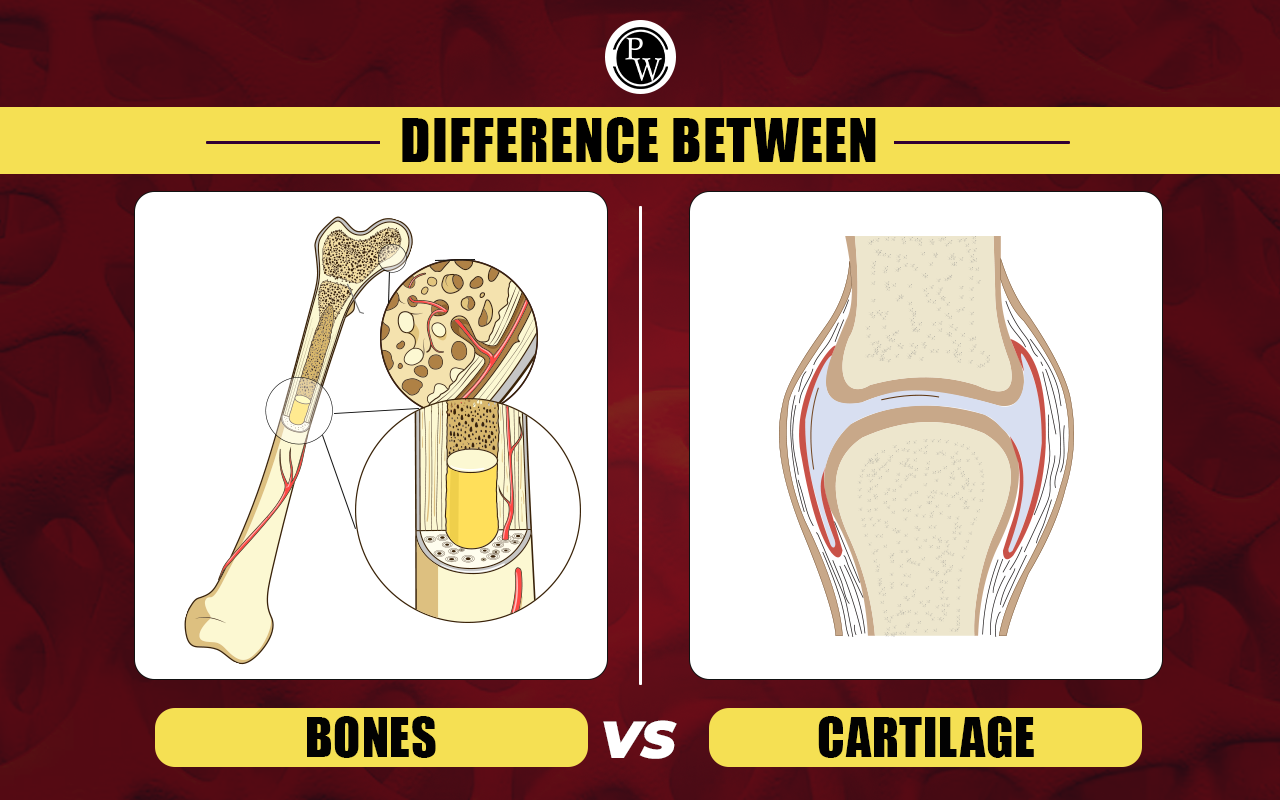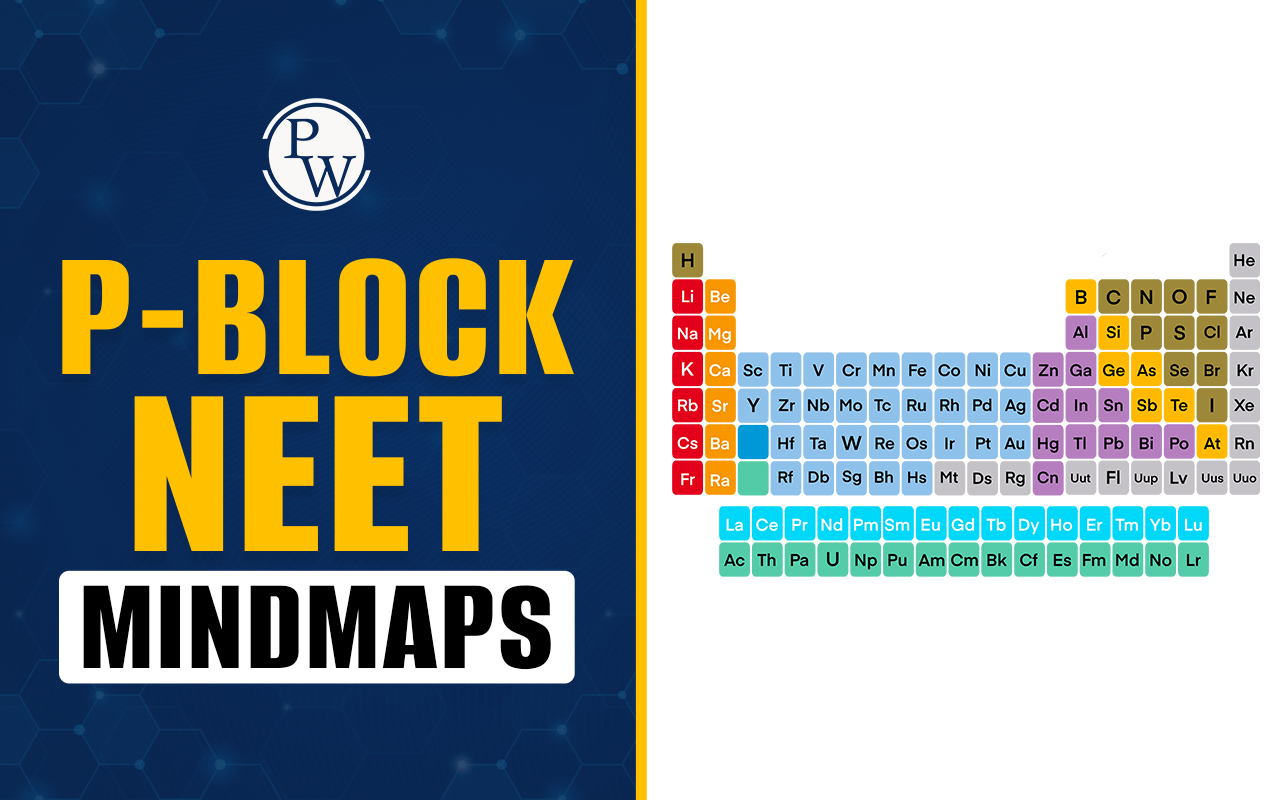

Difference Between Bone and Cartilage: Bones and cartilage are essential components of the human musculoskeletal system. They contribute to the body's form, function, and resilience. Bones act as a sturdy framework, providing structural support and protection. Bones are made up of mineralized collagen fibers, giving them strength and flexibility.
In contrast, cartilage is a flexible connective tissue that excels in areas that require flexibility and shock absorption. There are three types of cartilage: hyaline, elastic, and fibrocartilage. Cartilage plays a variety of roles, from joint support to developmental frameworks. Read this article for a more in-depth look at the differences between bone and cartilage.| NEET Biology Syllabus | NEET Biology Diagrams |
| NEET Biology MCQ | NEET Biology Chapter wise Weightage |
| NEET Biology Notes | NEET Previous Year Question papers |
Difference Between Bone and Cartilage Overview
Connective tissues are found in various forms in our bodies; two of the most significant are bones and cartilage. Bones are rigid and robust, similar to the framework of a building. They provide support, protect our organs, and allow us to move. Conversely, cartilage is a softer substance that acts as a cushion or flexible, rubbery material. It provides a smooth and comfortable range of motion for our joints, similar to the padding in our shoes. Bones and cartilage are essential topics in Biology, as they are important in keeping our bodies in good shape and functioning properly.
Difference Between Bone and Cartilage
The bones and cartilage are vital connective tissues. They distinctly contribute to the body's structural integrity and function. They are different from each other. Bones are rich in collagen. In contrast, cartilage excels in flexibility and shock absorption. The difference between bones and cartilage is as follows.| Difference Between Bone and Cartilage | ||
|---|---|---|
| Basis | Bone | Cartilage |
| Composition | Bones comprise mineralized collagen fibers, lending strength and resilience. | Cartilage is rich in collagen and proteoglycans, offering a flexible and resilient structure. |
| Minerals | It boasts a robust mineral content, predominantly calcium and phosphate | It exhibits minimal mineralization, contributing to its flexibility. |
| Functions | It is a robust framework, providing structural support and safeguarding organs. | It facilitates smooth joint movement, absorbs shocks, and maintains structural integrity. |
| Vascularity | Bones are highly vascularized, ensuring efficient nutrient exchange and robust repair capabilities. | Cartlages lack direct blood vessels, relying on nutrient diffusion through the matrix. |
| Nervous Supply | It is well-innervated for sensory functions and regulatory responses. | It lacks direct nerve supply, contributing to its pain-resistant nature. |
| Growth and Remodeling | It undergoes dynamic growth and continuous remodeling throughout life. | It is primarily involved in early skeletal development, with limited regenerative capacity in adulthood. |
| Location | It forms the fundamental structure of the skeletal system. | Found strategically in joints, nose, ears, and trachea for flexibility and support. |
| Repair Capacity | Bones possess efficient repair mechanisms due to their rich blood supply. | It displays limited repair capabilities, particularly in comparison to bone. |
| Flexibility | It is characterized by rigidity and hardness. | Cartilages offer flexibility and resilience, crucial for areas requiring movement. |
| Tissue Renewal | It continuously remodels, adapting to functional demands over a lifetime. | It exhibits limited regenerative abilities in adulthood, emphasizing maintenance over renewal. |
What is Bone?
Bones are the sturdy parts that make up our skeleton, providing a solid structure to support our bodies. They're like the framework that holds everything together. A mix of hard minerals, like tiny crystals, and flexible proteins, mainly collagen, strengthens bones. This combination gives bones the perfect blend of strength and a bit of flexibility. Inside our bones, different types of cells do essential jobs. Some cells build new bone, others break down old bone when needed, and some are like caretakers, ensuring everything stays balanced. It's like a construction crew and maintenance team working together to keep our bones healthy. Bones are well-connected to our body's blood supply, with tiny blood vessels running through them. This helps deliver nutrients, oxygen, and other important stuff to keep our bones happy and healthy. It also means that when a bone gets damaged, the body can send repair crews to fix thingsTypes of Bone
The human skeletal system comprises compact and spongy bones. Compact bone, dense and outermost, provides strength and protection. Spongy, inner, and porous bone enhances flexibility and houses bone marrow. The types of bone are as follows:
- Long Bones : Long bones, such as the femur and humerus, are characterized by their extended shape, being longer than wide. These bones are essential for supporting the body's weight and facilitating movement.
- Short Bones : Short bones, including the wrist carpals and ankle tarsals, exhibit a cube-like shape. Despite their small size, short bones play a significant role in providing stability to joints.
- Flat Bones : Flat bones, exemplified by the skull bones, ribs, and scapula, have a thin and flattened structure. One primary function of flat bones is to protect internal organs.
- Irregular Bones : Irregular bones, like the vertebrae and facial bones, exhibit complex and varied shapes. These bones often serve protective functions, such as supporting and enclosing delicate structures like the spinal cord or forming the framework of the face.
- Sesamoid Bones : Sesamoid bones, represented by the patella (kneecap), are embedded within tendons. These bones reduce friction, alter pressure, and provide a smooth surface for tendon movement.
Functions of Bone
Bones perform various functions. It provides structural support for safeguarding organs. They act as mineral reservoirs, especially for calcium and phosphate. Continual remodeling enables bones to adapt to mechanical stress, ensuring stability and equilibrium in the body. The functions of bones are as follows.
- Structural Support : Bones provide the framework that supports and maintains the body's shape.
- Protection : Bones act as a protective shield for internal organs, preventing damage from external forces.
- Movement : Bones facilitate a wide range of movements in collaboration with muscles and joints.
- Mineral Storage : Bones act like a storage unit for essential minerals, such as calcium and phosphate, helping to keep the right balance of minerals in our bodies.
- Blood Cell Formation : Inside certain bones, the bone marrow works like a factory, making different types of blood cells, including red blood cells, white blood cells, and platelets.
- Fat Storage : Yellow bone marrow, located in the central cavities of long bones, stores adipose tissue, serving as an energy reserve.
- Endocrine Regulation : Bones produce hormones, like osteocalcin, influencing energy metabolism and insulin secretion.
- Framework for Muscle Attachment : Muscles attach to bones via tendons, allowing bones to act as levers for movement.
What is Cartilage?
Cartilage is a unique and flexible connective tissue in various body parts. Unlike bone, cartilage is softer and more pliable, providing support and cushioning in areas where flexibility is essential. It's a softer, more bendable material than bone's more complex and rigid nature. One of the notable characteristics of cartilage is its composition, primarily consisting of chondrocytes embedded in a matrix of collagen fibers and a gel-like substance rich in proteoglycans. This combination allows cartilage to withstand pressure and provides a smooth joint movement surface. Cartilage doesn't have blood vessels, which makes it different from many other tissues. Instead, nutrients and oxygen reach the cartilage cells through diffusion from nearby blood vessels. While this limits its ability to repair and regenerate compared to bone, cartilage is well-suited for areas with flexibility, like the nose, ears, and the ends of long bones.
Types of Cartilage
There are three types of cartilage: hyaline, elastic, and fibrocartilage. All play a vital role in the human body. The explanation of these cartilages is as follows:- Hyaline Cartilage : Hyaline cartilage is characterized by its smooth and glassy appearance. It is primarily located at the ends of bones in joints, forming a friction-reducing surface.
- Elastic Cartilage : It contains more elastic fibers, imparting it with increased flexibility.
- Fibrocartilage : Fibrocartilage is tough and dense due to its high content of collagen fibers. It is located in areas under heavy pressure, such as intervertebral discs and specific joint ligaments.
Functions of Cartilage
Cartilage serves essential roles in the body. Hyaline cartilage reduces friction in joints, facilitating smooth movements. Elastic cartilage provides shape and flexibility to structures like the ears and nose. Fibrocartilage acts as a shock absorber. All functions of cartilage are given below.- Joint Support and Smooth Movement: Cartilage plays an essential role in joint support by forming a smooth surface at the ends of bones, reducing friction, and facilitating smooth joint movement.
- Shock Absorption and Resilience: It excels at absorbing shocks, especially in areas exposed to high pressure.
- Flexibility and Elasticity in Specific Structures: Cartilage provides flexibility and maintains shape in structures like the external ear.
- Developmental Role: It serves as a developmental framework during embryonic growth. It acts as a template for bone formation, particularly in the early stages of skeletal development, providing the necessary structure for subsequent bone growth.
Difference Between Bone and Cartilage FAQs
Is cartilage stronger than bone?
What are the three types of cartilage?
What is cartilage made of?
What is the weakest cartilage?
What are bones made of?












